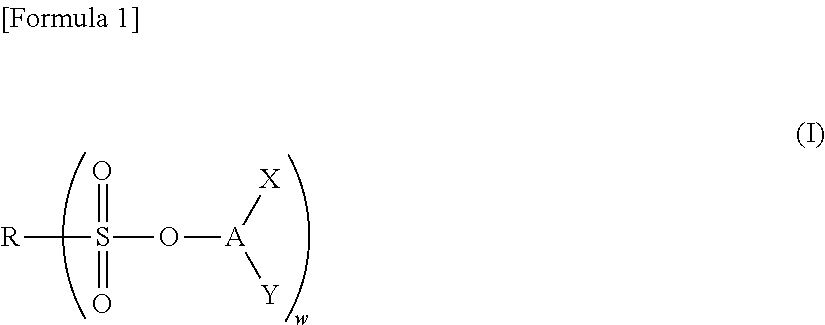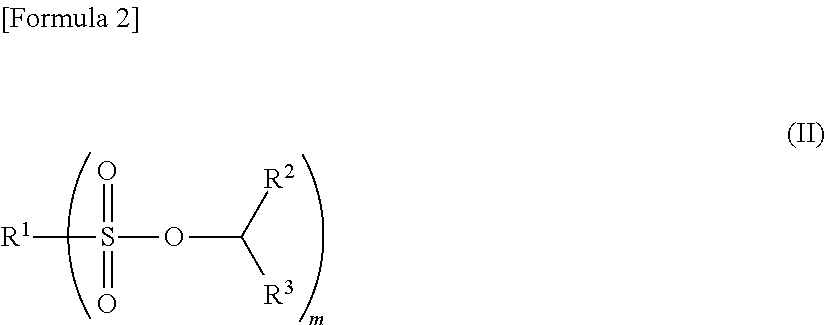Nonaqueous electrolyte solution and electrochemical element using same
a technology of electrolyte solution and electrochemical element, which is applied in the direction of non-aqueous electrolyte cells, electrochemical generators, transportation and packaging, etc., can solve the problems of lithium not being able to be smoothly absorbed onto and released from negative electrodes, the electrochemical characteristics of negative electrodes are liable to be worsened, and the cycle property of negative electrodes is worsened, so as to achieve the effect of improving the electrochemical characteristics
- Summary
- Abstract
- Description
- Claims
- Application Information
AI Technical Summary
Benefits of technology
Problems solved by technology
Method used
Image
Examples
examples
[0201]Examples of electrolytic solutions prepared by using the sulfonic ester compounds of the present invention are shown below, but the present invention shall not be restricted to these examples.
[0202]The low-temperature properties after charged and stored at high temperature and the low-temperature cycle property were evaluated by the following methods.
Evaluation of Low-Temperature Properties after Charged and Stored at High Temperature:
Initial Discharge Capacity:
[0203]A coin-type battery produced by the method described above was used and charged at a constant current of 1 C and a constant voltage up to a final voltage of 4.2 V for 3 hours in a thermostatic chamber of 25° C., and a temperature of the thermostatic chamber was lowered to 0° C. The battery was discharged up to a final voltage of 2.75 V at a constant current of 1 C to determine an initial discharge capacity at 0° C.
Charging and Storing Test at High Temperature:
[0204]Next, the above coin-type battery was charged at ...
examples i-1 to i-21 (
Invention I) and Comparative Examples I-1 to I-3
Production of Lithium Ion Secondary Battery
[0208]LiCoO2: 94% by mass and acetylene black (electroconductive agent): 3% by mass were mixed, and the mixture was added to a solution prepared by dissolving in advance polyvinylidene fluoride (binder): 3% by mass in 1-methyl-2-pyrrolidone and mixed to prepare a positive electrode mixture paste. This positive electrode mixture paste was coated on one surface of an aluminum foil (collector), dried and subjected to pressure treatment, and it was cut into a predetermined size to produce a positive electrode sheet. A density of parts excluding the collector of the positive electrode was 3.6 g / cm3. Further, 95% by mass of artificial graphite (d002=0.335 nm, negative electrode active material) coated with amorphous carbon was added to a solution prepared by dissolving in advance 5% by mass of polyvinylidene fluoride (binder) in 1-methyl-2-pyrrolidone and mixed to prepare a negative electrode mixtur...
examples i-22 and i-23 (
Invention I) and Comparative Examples I-4
[0210]Silicon (simple substance) (negative electrode active material) was used in place of the negative electrode active material used in Example I-2 and Comparative Example I-1 to produce a negative electrode sheet. Silicon (simple substance): 80% by mass and acetylene black (electroconductive agent): 15% by mass were mixed, and the mixture was added to a solution prepared by dissolving in advance polyvinylidene fluoride (binder): 5% by mass in 1-methyl-2-pyrrolidone and mixed to prepare a negative electrode mixture paste. Coin-type batteries were produced in the same manners as in Example I-2 and Comparative Example I-1 to evaluate the batteries, except that the above negative electrode mixture paste was coated on a copper foil (collector), dried and subjected to pressure treatment and that it was cut into a predetermined size to produce a negative electrode sheet. The results thereof are shown in Table I-3.
TABLE I-3Composition ofelectrolyt...
PUM
| Property | Measurement | Unit |
|---|---|---|
| open circuit voltage | aaaaa | aaaaa |
| temperature properties | aaaaa | aaaaa |
| temperature | aaaaa | aaaaa |
Abstract
Description
Claims
Application Information
 Login to View More
Login to View More - Generate Ideas
- Intellectual Property
- Life Sciences
- Materials
- Tech Scout
- Unparalleled Data Quality
- Higher Quality Content
- 60% Fewer Hallucinations
Browse by: Latest US Patents, China's latest patents, Technical Efficacy Thesaurus, Application Domain, Technology Topic, Popular Technical Reports.
© 2025 PatSnap. All rights reserved.Legal|Privacy policy|Modern Slavery Act Transparency Statement|Sitemap|About US| Contact US: help@patsnap.com



